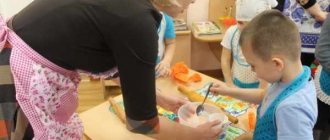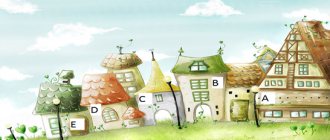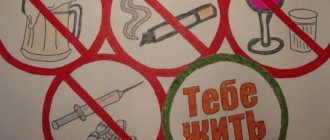Program content: 1. Give the concept of first aid for sunstroke, heatstroke, fainting, insect bites, bleeding, fractures, poisoning; 2. Introduce artificial respiration techniques, its meaning and necessity. 3. Continue to introduce the circulatory system 4. Nurture the moral and volitional qualities of the individual, mercy, compassion, mutual assistance, mutual assistance. 5. Activation of vocabulary: Artificial respiration, dislocation, proteins, etc.
Preliminary work: 1. Invite the head nurse to the group and talk about first aid, 2. Play the role-playing game “Ambulance”
Equipment: 1. telephone, 2. medical bag, 3. table “Providing first aid; for fractures and dislocations”, 4. scarf, 5. doll, 6. pencil.
Methodical techniques: 1. Surprise moment “Ambulance”. 2. Problem situation “Providing first aid”. 3. Teacher’s story “Medicinal herbs.” 4. Practical “Artificial respiration” 5. Visual “Display of the first aid kit” 6. Physical exercise “Pinocchio”. 7. Games. 8. Summary.
Progress of the lesson Educator: Our lesson today is unusual. Today we are not just children from kindergarten, but emergency medical personnel. Educator: Why do you need an ambulance? In what situations do we turn to it? Children: When a person suddenly becomes ill or has an accident, he needs to be given first aid. This will help preserve not only health, but also human life. Educator: Correct. Educator: But before the ambulance arrives, you can provide the necessary first aid. In such situations, you cannot waste precious seconds. Educator: What if the accident happened in the forest, far from the first aid station? Children: It is necessary to provide first aid and help the patient get to the nearest first aid station. Educator: That's right. How to provide first aid for bleeding, fractures, dislocations, fainting, sunstroke, if a person was drowning or was struck by lightning? We have already studied body hygiene in previous lessons. This is what will allow us to be medical workers today. Educator: Here comes the first call. Hello, what happened? Bleeding? Did the boy cut himself? Okay, I'll ask the children what needs to be done? Educator: Guys, the boy was seriously injured. He's bleeding. How can you provide first aid? What types of bleeding do you know? Children: Bleeding can be venous, arterial, or capillary. Educator: With capillary bleeding, the entire wound surface bleeds; it resembles a sponge. It is enough to treat such a wound and apply a bandage. The skin around the wound is treated with iodine or a solution of brilliant green (brilliant green). Educator: In case of venous bleeding, it is necessary to apply a tourniquet or make a pressure bandage using a scarf and a stick (demonstration on a doll) and treat the skin around the wound. Educator: With arterial bleeding, unlike venous bleeding, the blood flows not slowly, but quickly, flows like a fountain, and the color of the blood is not dark, but bright, scarlet. The bleeding can be stopped by pressing firmly with your fingers on the soft tissue above the wound, the artery is pressed until the bleeding stops, then a pressure bandage is applied to the site of the injury. If a bandage is not available, underwear can be used for this purpose. Educator: And yet, the most reliable remedy for injuries to the extremities is applying a tourniquet. In the field, a belt, scarf, scarf, belt, or rope can be used as a tourniquet. The limb should be pulled above the bleeding area to avoid pinching the skin; the tourniquet is best applied over clothing, then a stick is placed under it and twisted until the artery is compressed and the bleeding stops. It is very important to remember the time for applying the tourniquet, since you can keep it for no more than 1.5 - 2 hours, loosen the tourniquet a little every 20-25 minutes. Otherwise, limb necrosis may occur. Educator: Thank you, guys. I hope you helped the victim. What about the next call? Hello, what happened? Fell from a tree? Okay, I'll consult with the guys. Guys, what do you think could have happened? Does the boy have a fracture or dislocation? What types of fractures are there? There are open or closed fractures. How are they different? Children: With a closed fracture, the bone is damaged, but the bone does not come out. With an open fracture, the damaged bone comes out through the wounds. An open fracture is even more dangerous because infection can enter the body through the wound. What should be done to help the injured person? In case of fractures, first of all, it is necessary to immobilize the affected bone. To do this, most often you have to apply an improvised splint (stick, board, piece of plywood, etc.). The splint should be long enough to cover at least two joints above and below the fracture, and for shoulder or hip fractures, three joints. You often have to put linen under the tires instead of cotton wool and gauze. If there is no splint, in case of fractures, tie the broken leg to the healthy leg, and in case of arm fractures, hang the arm and tie it to the body, ensuring immobility. The correct bandage reduces pain and prevents the displacement of bone fragments. If the fracture is open, then the skin around the wound must be disinfected. So, guys, I see that you are quite capable of providing first aid for fractures. Educator: Here's another call. I wonder what else could have happened? Hello, what happened? Okay, I'll ask my guys what can be done? Guys, the girl was picking berries and didn’t notice a snake in the grass. She accidentally stepped on it, and the angry snake bit the girl. The poison must be sucked out of the victim's wound. But this should not be done for those who have fresh abrasions or wounds in the mouth. The sooner after a snake bite you begin to suck out the venom. To do this, you need to grab the bite site wide into the fold and quickly squeeze out a drop of liquid from the wound, then suck out the blood for 7-9 minutes, constantly spitting saliva. Then the wound must be lubricated with iodine or some kind of disinfectant. This procedure significantly reduces the amount of poison that enters the blood. You should also avoid anything that may increase blood circulation. The victim should not walk, much less run or ride a bicycle. It is better, if possible, to warm the victim and give him hot tea before sending him to the hospital. It must be transported in a supine position. Educator: Is only a snake capable of biting a person? Can a bee do this? Educator: What to do in such cases? Children: If you are stung by a bee, you must try to remove the sting from the sting site, as poison continues to be released from it for some time. The wasp, as is known, does not leave a sting after a bite and can bite repeatedly. In both cases, you need to wash the wound with alcohol and apply ice to the bite site. It reduces pain and prevents the development of edema. You can also use plantain or onion juice for this purpose. However, it is better to consult a doctor immediately. Educator: What needs to be done to prevent this from happening? Children: You should not approach beehives, especially on hot days, or make sudden movements near them, much less destroy wasp nests. Educator: That's right, guys. Educator: Here comes the next call. Hello, what happened? Okay, I'll consult with the guys. Educator: Guys, a man was poisoned by poor-quality food on a hike. What to do? Children: In case of food poisoning, the first step is to rinse the stomach. To do this, give the victim a liter of chilled boiled water to drink. Then he must unclench the root of the tongue with two fingers and thereby trigger a gag reflex. After this, the victim must eat 2-3 tablets of activated carbon, which absorbs harmful substances, preventing them from spreading along with the blood throughout the body. Educator: Guys, our duty continues. (Ringing) Yes, I'm listening. What? Was he struck by lightning? Is he unconscious and not breathing? Educator: Guys, let's help. What to do in such a situation? Children: Here you need to act quickly and decisively: artificial respiration and cardiac massage are necessary. It is completely unacceptable and, most importantly, dangerous to bury those struck by lightning in the ground. This makes breathing even more difficult. Don't waste a second of precious time. Place the victim on his back, preferably on something (a shield, a board). Your legs should be elevated. Throw your head back in this position, air flows better, and blood flow to the heart is created. Through a clean handkerchief, pressing your mouth tightly to the victim’s mouth and at the same time pinching his nose, forcefully blow air from mouth to mouth. After each such inhalation, open your mouth and unclench the victim’s nose to freely exhale from the lungs, the so-called artificial exhalation. At the same time, perform a cardiac massage: with one hand, quickly press on the lower part of the chest, with the other, on the back surface of the first hand and lower it. Exhale once for 4 pushes. It is better to perform artificial respiration together, but one person can do it. The procedure must be continued until spontaneous breathing appears, heart function resumes, and the victim can be taken to a doctor. Educator: Or it could happen that a person has just been pulled out of the river and he is also not breathing. What to do this time? Children: Turn the victim onto his stomach and place him on his knee. Open his mouth so that all the water flows out. Then lie on your back, unclench your teeth and clean your mouth from dirt, sand, and debris with a handkerchief. And then do artificial respiration. (Demonstration on a doll). Educator: Well done! Here's the next call. Is the person burned? Where? In the forest? Let's help now! Guys, a man fell asleep by the fire - and suddenly his clothes caught fire. What to do? Children: Immediately place a blanket, tarpaulin, raincoat or other thick fabric over him and hold him tightly to his body. If the clothing continues to smolder, fill it with water and only then remove it very carefully, trying not to damage the skin, without tearing off pieces of fabric stuck to the body. Only first aid can be provided on site. Do not lubricate the skin with ointments or oil - this makes surgical treatment of the wound more difficult. Educator: Hello! Yes, sunstroke? What to do? So, let's help provide first aid. To do this, the victim must be moved to the shade, laid down so that the head is higher than the body, and the face and chest must be doused with cold water. If the victim does not regain consciousness, give ammonia a sniff. Educator: What is the difference between sunstroke and fainting? Children: When a person gets sunstroke, he becomes “red,” and when he faints, he becomes pale as “snow.” And further. Sunstroke causes headache, nausea, and vomiting.
Educator: What should you do if you faint? Children: Lay the person down so that the legs are elevated, unfasten all belts, collars and, if the victim does not come to his senses, let him smell ammonia. Educator: Well done! What medicinal herbs do you know? Children: Raspberries, currants, nettles, plantain... Educator: That's right. What healing properties do they have? Children: For example, a decoction of raspberries, currants, as well as St. John's wort, "matryoshka" is used for colds. Educator: Correct. You often go outdoors in the summer, and the most unexpected situations may arise. There is no doctor nearby, you can’t call an ambulance. And often - no medicines at hand, not even iodine, bandages... What to do? Children: It is very important not to get confused in such an environment. If you know the properties of medicinal plants well, they will always come to your rescue. And first of all, this applies to the treatment of wounds, abrasions and scratches. Educator: Many of you have more than once encountered an ash tree in the forest and admired its beauty. However, not everyone knows that ash bark can heal wounds. To do this, the bark must be removed from a not very young and not very old branch and the succulent side applied to the wound. It will take a few days and the wound will heal. Educator: Who can tell what properties nettle and plantain have? Children: If you crush the leaves of these plants and then apply them to the wound, you can stop the bleeding. Educator: Well done! Do you know that in the old days, when a mower wounded his leg, he immediately sprinkled the wound with greenish-brown pollen (spores) of a mature puffball mushroom, tightly pressing the cut with the velvety skin of the same mushroom turned inside out. And it helped a lot. For a long time, fireweed (fireweed) has been used in the same way as cotton wool. Reeds, which were valued as “cut” grass, were used for the same purpose. The top layer was peeled off the reed and the snow-white core, reminiscent of cotton wool, was taken out. Applied to the wound, it stopped the bleeding. The burning red juice of lungwort can replace iodine. And white moss can be used as a dressing that has disinfectant properties. You can find out more by reading books about medicinal plants and asking your parents and grandparents about them. And yet, guys, in order not to take risks, you need to carry with you on hikes or walks in the forest... Children: A camping first aid kit. Educator: Correct. What does it contain? Children: The medical kit should contain a bandage, cotton wool, iodine, brilliant green, a tourniquet, a tube for artificial respiration, a notepad, a pencil, ammonia (ammonia) and various medications. (Display and viewing of the first aid kit).




